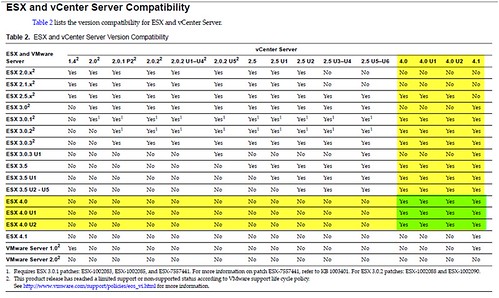Old habits can be hard to break. Such was the case today when I called out an individual for producing an ESXi 4.0 Update 2 upgrade document without referencing the requirement to upgrade vCenter 4.0 Update 1 to Update 2 first as a prerequisite.
Up until the release of vSphere 4.0 Update 1 back in November of 2009, the VMware virtual infrastructure upgrade path was such that the vCenter Server was upgraded to the newer release, then the ESX(i) hosts were upgraded afterward.
As shown in the ESX and vCenter Server Compatibility matrix below, beginning with vSphere 4.0 Update 1, ESX(i) hosts can be upgraded ahead of their vCenter Server counterparts. In fact, VMware allows a radically wider in versioning variation in that vCenter 4.0 (released May 2009, with no update) is compatible with ESX(i) 4.0 Update 2 which was released in June 2010, over a year later.
After being corrected, I recalled hearing of this new compatibility some time back but the bits had fallen off the platter. For the record, I’m not always right. I’m fine with being wrong. It happens plenty enough. For me, it’s all about the learning. Retaining the knowledge is an added benefit but isn’t always guaranteed if not used on a regular basis.
This mantra will provide some flexibility which may be needed to upgrade smaller groups of clusters or hosts (say for troubleshooting purposes) without impacting the centralized vCenter Server which in turn would impact the remaining clusters or hosts it manages by way of agent upgrades blasted out to each attached host.
Before you celebrate in the end zone Dallas Cowboys style, do note from the chart above that the upgrade to vSphere 4.1 reverts back to the old methodology of upgrading the vCenter Server first, and the attached ESX(i) hosts afterward. In other words, ESX(i) 4.1 is ONLY compatible with vCenter Server 4.1.
Go Vikings!


















Vikings = ESX 2.0.
Unfortunately, I cannot disagree with you on that Mr. X, based on last night’s 1st half performance. Ugh.